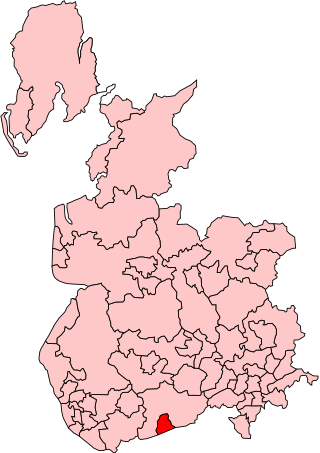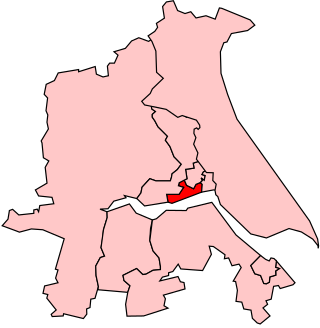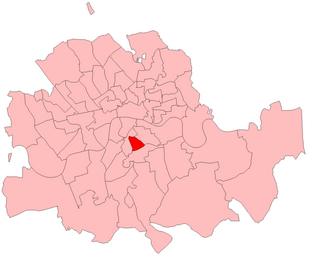Wigtownshire, was a Scottish constituency of the House of Commons of the Parliament of Great Britain from 1708 to 1801 and of the Parliament of the United Kingdom from 1801 to 1918. It was represented by one Member of Parliament.
East Grinstead was a parliamentary constituency in the Kingdom of England, the Kingdom of Great Britain, and the United Kingdom. It first existed as a Parliamentary borough from 1307, returning two Members of Parliament to the House of Commons elected by the bloc vote system. The borough was disfranchised under the Reform Act 1832, but the name was revived at the 1885 election when the Redistribution of Seats Act created a new single-member county division of the same name.

Warrington was a parliamentary constituency in the United Kingdom. From 1832 to 1983 it returned one Member of Parliament (MP) to the House of Commons of the Parliament of the United Kingdom.
Shrewsbury was a parliamentary constituency in England, centred on the town of Shrewsbury in Shropshire.
Torquay was a county constituency in Devon, South West England, which returned one Member of Parliament to the House of Commons of the Parliament of the United Kingdom.

Salford West was a parliamentary constituency in the City of Salford in Greater Manchester from 1885 until 1983. It returned one Member of Parliament (MP) to the House of Commons of the Parliament of the United Kingdom.

Whitechapel was a parliamentary constituency in the Whitechapel district of East London. In 1885 the seat was established as a division of the parliamentary borough of Tower Hamlets. It returned one Member of Parliament (MP) to the House of Commons of the Parliament of the United Kingdom.
Leek was a parliamentary constituency in Staffordshire which returned one Member of Parliament (MP) to the House of Commons of the Parliament of the United Kingdom.

Kingston upon Hull West was a borough constituency in Kingston upon Hull which returned one Member of Parliament (MP) to the House of Commons of the Parliament of the United Kingdom from 1885 until it was abolished for the 1918 general election.

Skipton was a county constituency centred on the town of Skipton in Yorkshire which returned one Member of Parliament (MP) to the House of Commons of the Parliament of the United Kingdom.
Holderness was a parliamentary constituency centred on the Holderness area of the East Riding of Yorkshire. It returned one Member of Parliament (MP) to the House of Commons of the Parliament of the United Kingdom.
Woodbridge was a county constituency centred on the town of Woodbridge in Suffolk. It returned one Member of Parliament (MP) to the House of Commons of the Parliament of the United Kingdom.

Harrow was a constituency of the House of Commons of the UK Parliament 1885—1945 in Middlesex, a traditional county; it covered an area forming part of the north-west of today's Greater London. It returned one Member of Parliament (MP).
Bury was a borough constituency centred on the town of Bury in Lancashire. It returned one Member of Parliament (MP) to the House of Commons of the Parliament of the United Kingdom.

Walworth was a parliamentary constituency centred on the Walworth district of South London, within the Newington Vestry. It returned one Member of Parliament (MP) to the House of Commons of the Parliament of the United Kingdom.
East Dorset is a former United Kingdom Parliamentary constituency. It was formally known as the Eastern Division of Dorset. It was a constituency of the House of Commons of the Parliament of the United Kingdom. It was represented by one Knight of the Shire.
Dudley was a parliamentary constituency centred on the town of Dudley in Worcestershire which existed between 1832 and 1974. It returned one Member of Parliament (MP) to the House of Commons of the Parliament of the United Kingdom, elected by the first past the post system.
Droitwich was the name of a constituency of the House of Commons of England in 1295, and again from 1554, then of the House of Commons of Great Britain from 1707 to 1800 and of the House of Commons of the Parliament of the United Kingdom from 1801 to 1918. It was a parliamentary borough in Worcestershire, represented by two Members of Parliament until 1832, and by one member from 1832 to 1885. The name was then transferred to a county constituency electing one MP from 1885 until 1918.
East Worcestershire was a county constituency in the county of Worcestershire, represented in the House of Commons of the Parliament of the United Kingdom.

John William Wilson, PC, JP was a British chemical manufacturer and politician who served for 27 years as a member of parliament (MP), initially as Liberal Unionist and then as a Liberal.









